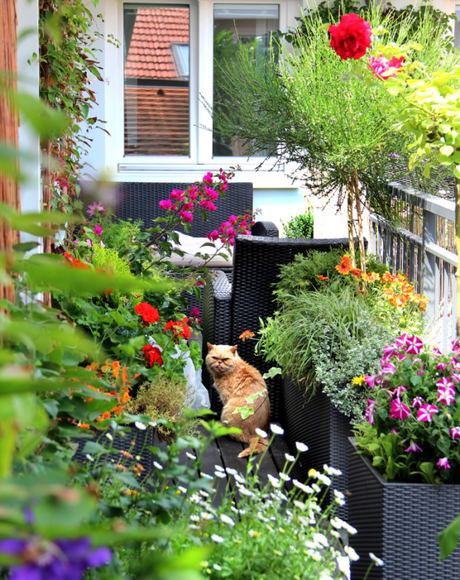For in the true nature of things, if we rightly consider, every green tree is far more glorious than if it were made of gold and silver. Martin Luther
With high rise buildings and concrete jungles increasingly becoming the order of the day, the need to connect with green spaces has never been stronger. Green cover in the form of trees and plants is an instant way to recharge your energies and rejuvenate. Needless to say, it is soothing on the eye and makes for a healthier way of living. After all, there is nothing like coming home to your own garden and relaxing at the end of a long tiring day. “Plants add a contrast to hard surfaces, thus creating a softer look. Most of us find it easier to overcome stress when we are in a natural environment. They also aid in increasing the productivity of work.” says Priyanka Mehra, Principal Architect PS Design.

Space not a constraint
While everyone appreciates the importance of green spaces, it is more of a misconception that you need to live in big bungalows or independent houses in order to enjoy the benefits of a garden. “One doesn’t need to reside in a pastoral setup to keep up the resolve to be eco-friendly. Amidst the chaos of urban life and the advent of hi-rises, the best way to enjoy nature is by welcoming the outdoors inside!” says Arshi Mukri, Design Expert, Pepperfry. So, no space is small enough and the key is to bring the outdoors into indoor areas.

Creating green nooks within the house not only enlivens the space but also gives it a much-needed character. “One of the biggest ways to make an impact in a small space is to use spaces or corners that you traditionally would not consider for a garden. For e.g. a bathroom can be a perfect habitat for some type of plants like Sanseveria and Chlorophytum. We all have a corner in our bedrooms that just stares right back at us. Pull in an areca palm (an air purifying plant) and you’ve added an element of jungle right where you sleep” says Annu Grover, Founder & MD of Nurturing Green. The best part about most indoor plants is that they help keep the air inside clean, fresh and some even keep pests at bay.

Beyond the balcony
While, balconies are usually reserved and associated for small gardens, you can have little patches of green almost anywhere in the house. Whether it is the living room, bedroom or even the kitchen, plants form a great fit anywhere. “One can have green patches at the entrances, kitchen gardens near kitchen windows and zen gardens in living rooms” says Vaishnavipratima Kodakalla, interior designer and founder, Vaishnavipratima, The Interiors Studio. If your house has a staircase, then using it is also a great idea. “You can also keep pots at the edge of every staircase giving the ladder a poised look and making the home into a greener one. If you have a child at home, you can help them plant a seed in a portable box which can be shifted to different places around the house and fix wherever space permits” says Vaibhav Jain, CEO, Deco Window.

Nothing is more exciting than having your kitchen garden, a green space where you can grow your own herbs and use them for your daily cooking. Fresh basil, oregano, thyme, coriander, fenugreek and even green chillies grow well in small pots. “A herb garden can be a vertical garden patched on one corner of your wall or even on the kitchen window sil provided you have sunlight” says Parakh Jindal of Ayushi Kanodia Designs.

A key point to note is that plants should give the much-needed refreshing vibes than make the space look cluttered and feel claustrophobic. So, the best way is to strike a balance and start slow. If the space is big, large planters with palms or even Fiddle leaf fig plant can add to the style quotient. If the indoor place is small, cacti and succulents are good choices. “Get indoor potted plants of varying heights, color and texture. Place them together in a corner with a fountain in between which compliments the overall height of the composition to create a green zone. You can also make a 3-plant or a 5-plant bouquet and have it as a centrepiece either in the living room or on the dining table” says Dipti Das, head of Design, HomeLane. Creating your own terrarium in glass jars is a wonderful way of incorporating plants. Friendship plant, star fish plant, spider ferns and aquamarine are suitable for terrariums. Add in some colourful pebbles and you have a showstopper!

Go Vertical, think ‘out of the box’
When floor space is limited, take advantage of walls and create vertical gardens. While hanging pots is a good idea, old racks and shelves can vertically fit a lot of planters. “There are several planters available today which can be mounted on the walls and can create a beautiful composition. If you have an option, hang your plants from Macrame plant hangers to create a quirky space. Grid Vertical gardens are also very easy to install and maintain” says Priyanka Mehra, Principal Architect of PS Design.

And when it comes to styling your little garden there is no dearth of quirky and bohemian options. Place your plants on an old sewing machine table or even a worn-out ladder to add to the rustic charm. Mason jars, old wine bottles, discarded pickle jars and jute planters add an earthy appeal to any space. Bottles and baskets are great ideas too.

This article was originally published in Sakal times here.
